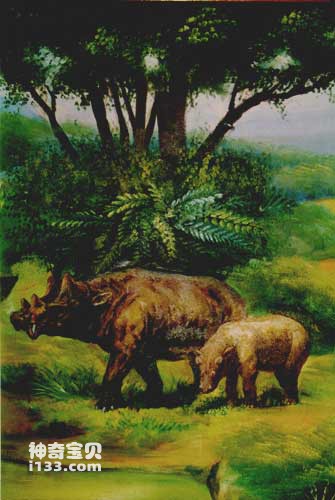The earliest true beasts were insectivores (order) that appeared in the Cretaceous. After entering the Cenozoic Era, the eutherians differentiated from this basis and evolved at a very fast speed, resulting in a wide range of adaptive radiation. The first change in the history of Cenozoic mammals occurred from the Paleocene to the Eocene. An evolutionary explosion; as a result of the explosion, an ancient group of mammals adapted to various ecological environments occupied a dominant position in the Paleocene and Eocene. This group of ancient mammals includes the following groups:

Mole - a living insectivore
A large number of primitive groups in the insectivores (order).
Chiroptera (order): The masters of flight among mammals. They likely diverged from insectivorous ancestors very early and evolved rapidly during the early stages of their evolution, as the known Eocene bats were already highly developed and were not significantly different from their modern relatives. There is a difference. Bats continuously emit an ultrasonic wave when flying. When there are obstacles or insects in front of them, the ultrasonic waves are reflected back; when the bat's ears feel this "echo", they can take avoidance or predatory behaviors. Bats are therefore able to fly and hunt at night without relying on vision. This special adaptation may be why they have managed to survive to this day.

flying monkey
The ancestral type of Dermoptera (order), its descendants, flying monkeys, have continued in the tropical forests of Southeast Asia until modern times.
The ancient anthodontia in the class (order) of anaerobia.
Neurates (order).
Schistodonts (order): This is a group of strange large animals that lived in the Early Tertiary Period, such as Schistodonts, which were as big as a large bear; they had strong bones, heavy limbs and clawed "hands and feet" "They are also very similar to bears. However, their skulls are very similar to rodents, with enlarged chisel-shaped incisors on their upper and lower jaws.
The lower primates in the primates (order) include the extinct flat monkeys, brachial monkeys, and more monkeys, as well as lemurs, slow lorises, and tarsiers.
(Hya) mammals (order): small animals whose bones are similar to those of lagomorphs and rodents. It first appeared in the Cretaceous period, had many species in the Paleocene period, and became extinct in the early Oligocene period. It is an animal endemic to Asia, with the largest number in my country, and its main representatives include Acrodontus, Pseudodontus, Pseudomonassaurus, Erythrodontus, and Pikachus, etc.
Paleocarnivores (order): A group of ancient carnivorous mammals that appeared as early as the Late Cretaceous, including Trigodonts, Pleurodonts, Hyaenodonts, and Hyenas. Most of them became extinct at the end of the Eocene, and only hyaenodonts survived until the early Pliocene.
Anthropods (order): Primitive ungulates of the Paleocene and Eocene epochs. They are the most primitive ungulates that evolved from insectivores. Including two families: Canidae and Mesotheridae.

Ewingmon
Amblypods (order): Originated from the anklets in the Paleocene Epoch, they are a group of ungulates that developed to gigantic size in the early stages of evolution. Representative animals include crocodonts, direhorns, etc. Most became extinct at the end of the Eocene, and a few species survived in Asia until they became extinct after the Oligocene. The pinnacle representative of its evolution is the late Eocene Eocene animal, which is as big as a large rhinoceros; it has a long skull with 6 strange horns - two small horns on the nose, two above the canine teeth, and two small horns. One is on the back of the head.
Southern ungulates (order): A group of primitive ungulates that originated from a certain anklet ancestor in Asia in the late Paleocene, migrated to North America in the early Eocene and continued to migrate to South America, and then were only distributed in South America. Among them, the type beasts and the heigotheres were extremely diverse and prosperous in the middle of the Tertiary Period, and some species continued into the Pleistocene.
Talus (order): A certain kind of anklet that originated in South America in the Paleocene, and then was restricted to the South American continent and survived until the Pleistocene ungulates. Among them, the proto-equine animals developed very similarly to horses, and also experienced the process of gradual degeneration of the side toes. When the real horses invaded South America from the North American continent in the Pliocene Epoch, the proto-equine beasts failed in the competition with the real horses and became extinct. The opisthodonts were physically similar to North American camels, but their snouts were likely to have a short, retractable snout like modern tapirs.
Shemotherians (order): A certain kind of anklet that originated in South America in the Eocene, and then was restricted to the South American continent until the Miocene. They had already developed towards huge bodies in the early stages. The aphrodisiacs of Oligocene and Miocene epochs stood more than 1.5 meters tall at the shoulders.
Pyrotheria (order): Huge South American ungulates that lived only in the Early Tertiary Period. They were probably one of the relict species of some kind of anklet.

Tarsier
Heteroungulates (order): Another South American ungulate from the Paleocene, probably one of the relict species of some kind of anklet.
On most of the earth's landmasses, this huge group of ancient mammals was basically replaced by the ancestors of modern mammals at the end of the Eocene. Only a few groups remained in later eras, and individual species such as lemurs, Tarsiers and other species still live in individual areas on the earth. However, South American ungulates, including southern ungulates, talus, amphibians, pyrozoans and heterodactyls, continued to multiply and differentiate during most of the Cenozoic due to the unique environment isolated from other continents. Among them, the southern ungulates continued until the Pleistocene, and the talus did not become extinct until the Pliocene.
animal tags: Tarsier ewing mole primate chiroptera
We created this article in conjunction with AI technology, then made sure it was fact-checked and edited by a Animals Top editor.